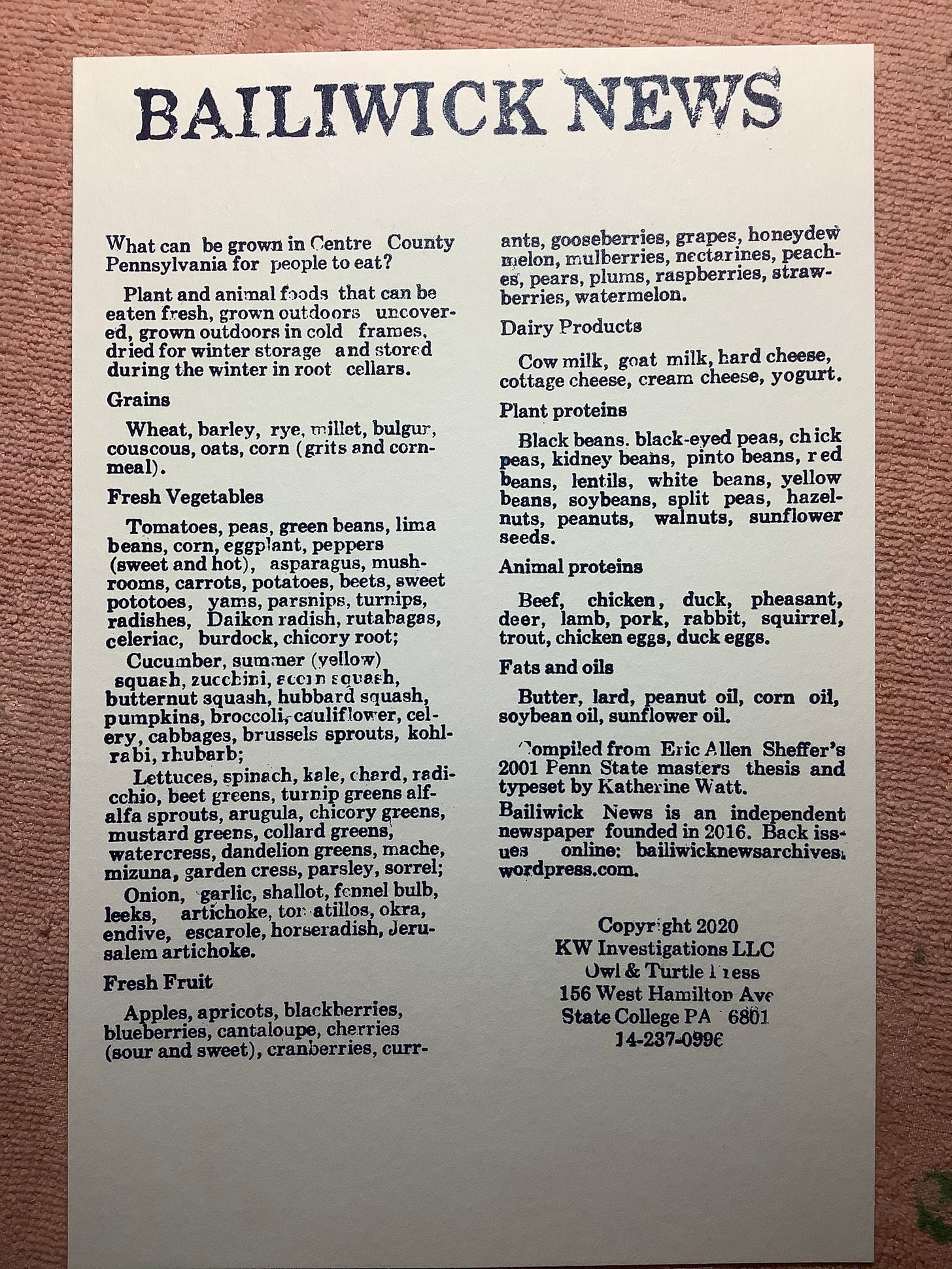Regional food security: food that can be produced in Centre County, Pennsylvania
Repost from April 2020
For readers who may be looking at the snarled supply chains, looming food shortages, and rising inflation, and thinking about planting or expanding backyard gardens, and supporting regional farms and farmers, here’s a a repost from April 2020, which was followed by another, land-analysis post in July 2020. A third installment was planned but not written.
What foods can be grown and raised in Centre County, Pennsylvania?
Below is the first part of my effort to read and summarize the key points in Eric Allen Sheffer's 2001 master's thesis looking at the Centre County population and land base capacity for nutritional self-sufficiency.
Sheffer's main assumptions included a target diet providing 2,800 calories per person per day (1,022,000 calories per person per year), for a population of 136,000 (as of the 2000 census).
He used the 1996 USDA Food Guide Pyramid to set up targets for protein, carbohydrates, fats, and vitamins and minerals including Vitamin A, Vitamin C, Vitamin B- 2, Vitamin B-6, Folate, Vitamin B-1, Niacin, Vitamin B-12, Sodium, Calcium, Magnesium, Zinc, Phosphorus, Iron.
This first piece of the puzzle simply lists the foods Sheffer concluded can feasibly be produced and stored in the Centre County climate: plant and animal-based foods that can be eaten fresh, grown outdoors uncovered, grown outdoors in cold frames, dried or pressed for long-term storage and/or stored during the winter in root cellars.
Grains
Wheat, barley, rye, millet, bulgur, couscous, oats, corn (grits and cornmeal)
Fresh Vegetables
Tomatoes, peas, green beans, lima beans, corn, eggplant, peppers (sweet and hot), asparagus, and mushrooms; carrots, potatoes, beets, sweet potatoes, yams, parsnips, turnips, radishes, Daikon radish, rutabagas, celeriac, burdock root and chicory root; cucumber, summer (yellow) squash, zucchini, acorn squash, butternut squash, Hubbard squash and pumpkins; broccoli, cauliflower, celery, cabbage (multiple varieties), brussels sprouts, kohlrabi and rhubarb; lettuces, spinach, kale, chard, radicchio, beet greens, turnip greens, alfalfa sprouts, arugula, chicory greens, mustard greens, collard greens, watercress, dandelion greens, mache, mizuna, garden cress, parsley and sorrel; onion, garlic, shallot, fennel bulb and leeks, artichoke, tomatillos, okra, endive, escarole, horseradish and Jerusalem artichoke.
Fresh Fruits
Apples, apricots, cantaloupe/musk melon, cherries (sour and sweet), cranberries, currants, gooseberries, grapes, honeydew melon, mulberries, nectarines, peaches, pears, plums, raspberries, strawberries, watermelon.
For classification purposes in Sheffer's study, "whole fruits" included things like apples, apricots, peaches, pears, plums, usually consumed whole, and "chopped fruits" included things consumed by the cup or bowl, such as like melons and berries.
Dairy Products
Cow milk, goat milk, hard cheese, cottage cheese, cream cheese and yogurt.
Plant-proteins: dried beans, nuts and seeds
Black beans, black-eyed peas, chickpeas, kidney beans, pinto beans, red beans, lentils, white beans, yellow beans, soybeans, split peas; hazelnuts, peanuts, walnuts, sunflower seeds.
Animal proteins: meat, poultry, eggs and fish
Beef, chicken, duck, pheasant, deer, lamb, pork, rabbit, squirrel, trout, chicken eggs, duck eggs
Fats and oils
Butter, lard, peanut oil, corn oil, soybean oil, sunflower oil.
From the July 2020 land use report:
“…Sheffer concluded that adequately feeding 136,000 people from Centre County farms growing minimally-processed, locally-transported foods to meet the recommendations from the 1996 USDA Food Guide Pyramid, would require about 49,000 acres for meats and protein beans, 34,500 acres for grains, 9,400 acres for dairy products, 5,800 acres for fruits, and 2,000 acres for leafy and non-leafy vegetables, for a total of just under 101,000 acres.
Sheffer concluded that - with some changes in land use and crop production (for example, decreasing grass production and increasing small grain and orchard production) - Centre County farmland could support the county population of 136,000 (as of 2000 census), at a carrying capacity of roughly one person per 0.74 acres of farmland.
He extrapolated that if Centre County’s 116,000 total acres of farmland (as of 2001), were fully planted in the types and quantities of crops suggested by his analysis, local farming in Centre County could support a maximum county population of about 157,000.
The peak of fruit variety would be each July, with about 12 different fresh fruits. Vegetable variety would peak each September, with about 60 types of fresh vegetables available from outdoor production.
The winter diet - using stored vegetables in root cellars and fresh vegetable grown in cold frames - would include about 26 types of vegetables, and winter-stored apples and pears, along with home-canned or frozen summer fruits.”
For fun, I typeset the food list in 10-point Century Schoolbook font and printed it on my homemade bottlejack printing press.




